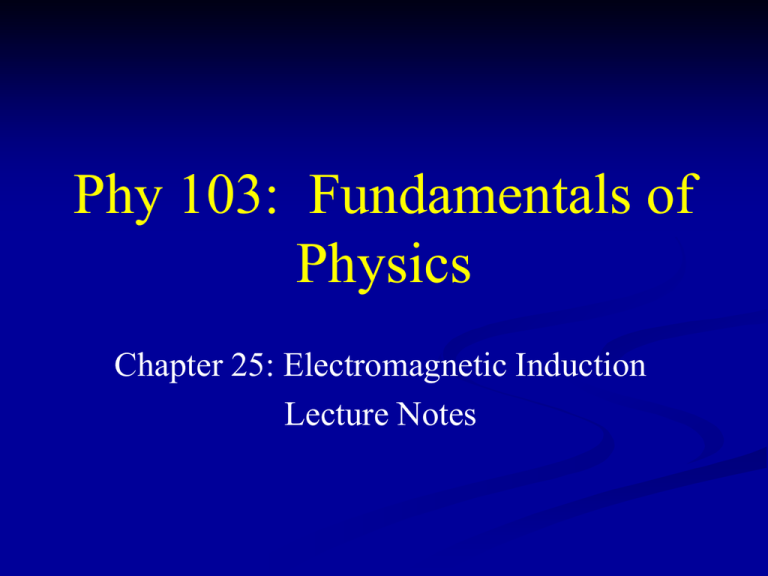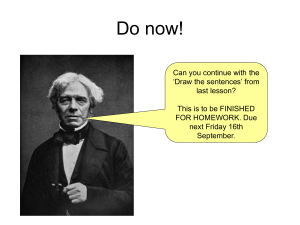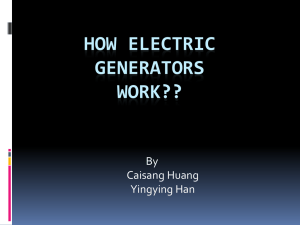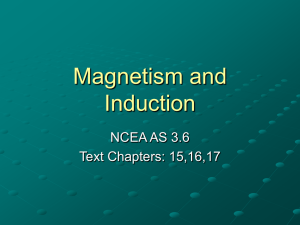Phy 103: Chapter 22
advertisement

Phy 103: Fundamentals of
Physics
Chapter 25: Electromagnetic Induction
Lecture Notes
Electromagnetic Induction
So far we have observed that an electric current
produces a magnetic field
Question: Can a magnetic field produce an electric
current?
Answer: Yes!
It’s called electromagnetic induction!!
When a magnetic field is changed near a wire loop, a
voltage (called electromotive force) is induced in the wire
The resulting voltage generates an electric current
The size of the voltage depends on how fast you change the
magnetic field
The size of the current depends on the resistance in the wire
as well as the induced voltage (remember Ohm’s Law?)
Faraday’s Law
The product of the area of a loop of wire (coil) times the
magnetic field inside the wire is called the magnetic flux
(F)
F = B.A
When the magnetic flux changes, a voltage is induced in
the coil. The induced voltage (V) is related to:
The number of loops (N) in the coil
The rate at which the magnetic flux is changing (DF/t) inside
the loop(s), or
N D(F ) N D( BA)
V
t
t
{Faraday’s Law}
Note: the magnetic flux changes when either the magnetic field
(B) or the area (A) of the loop changes:
DF = A.DB
or
DF = B.DA
Generators & Alternating Current
Electromagnetic induction can be used to produced
electricity
A device that does this is called an electrical generator
Generators convert mechanical energy into electrical
energy
Mechanical energy is utilized to either:
rotate a magnet inside a wire coil
Rotate a wire coil inside a magnetic field
In both cases, the magnetic flux inside the coil changes
producing an induced voltage
As the magnetic or coil rotates, it produces an alternating
current (AC) {due to the changing orientation of the coil
and the magnetic field}
Types of generators:
Turbine driven (turbo-) generators
Magnetohydrodynamic generators (MHD)
Michael Faraday (1791-1867)
A self-trained English physicist
Perhaps the greatest experimenter
who ever lived
Note: since he was self taught, he
did not grasp mathematics!!!
Major contributions to physics:
Developed the concept of fields (electric and magnetic) or as
he called them, “lines of force”
invented the dynamo (a device capable of converting
electricity to motion)
discovered electromagnetic induction
devised the laws of chemical electrodeposition of metals
from solutions
Transformers
Devises that utilize electromagnetic induction to
increase or decrease the maximum voltage of an AC
power source
Key features:
Primary coil (input): connects to AC power source &
generates the magnetic field
Secondary coil (output): connects to the “load circuit” &
reacts to the magnetic field produced by primary coil
Relationship between primary coil and secondary
coil:
V primary
where:
N primary
Vsec ondary
N sec ondary
V is the voltage of primary or secondary coil
N is the number of coils in primary or secondary coil
Transformers (cont.)
Transformers obey conservation of energy law:
Powerprimary = Powersecondary
Power input at primary coil will always be greater or
equal to the power output at the secondary coil
Power Transmission
To transport electric power over large distances:
voltages are stepped up
Currents are stepped down
Power = Voltage x Current
or
P = V.I
Lower currents result in less power loss (due to heat)
Transformers (at front end) are used to step up the
voltage and lower current
Transformers (at back end) are used to step down the
voltage and increase current for consumer usage
Field Induction
Faraday’s Law in terms of fields:
An electric field is induced in any region of space in which
a magnetic field is changing with time
E ~ DB/t
The direction of the electric field is at right angle to the
changing magnetic field
Maxwell’s counterpart to Faraday’s Law:
A magnetic field is created in any region of space in which
an electric field is changing with time
B ~ DE/t
The direction of the magnetic field is at right angle to the
changing electric field





